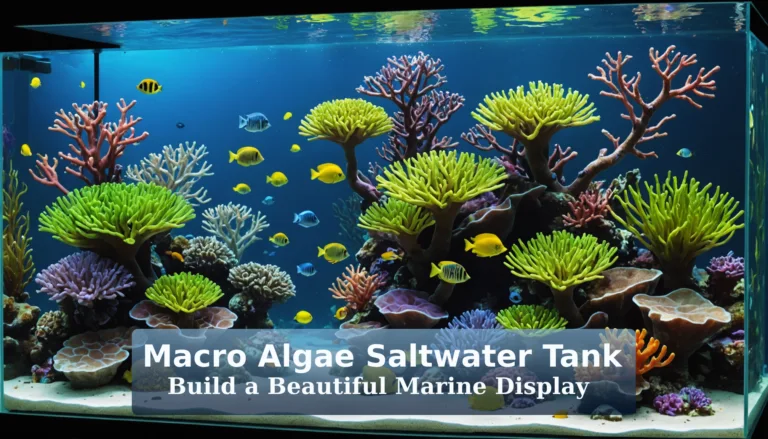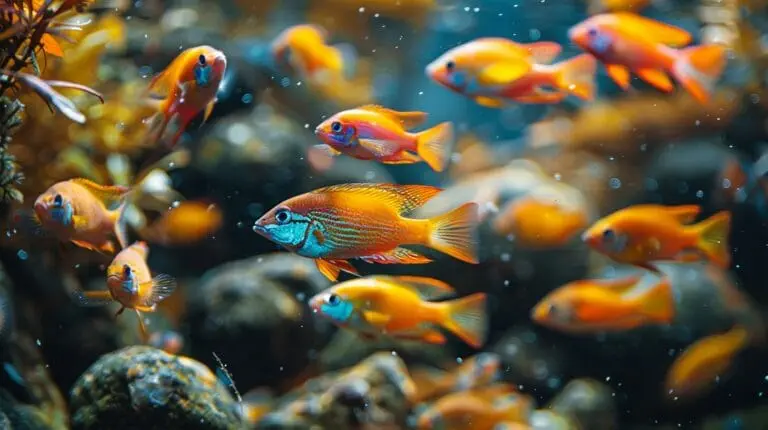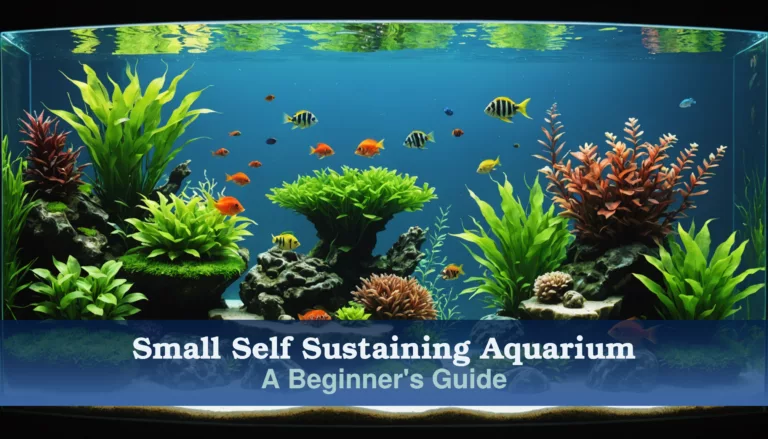Choosing the right water conditioner is like finding the secret ingredient for a delicious recipe—without it, your fish could be in real trouble! The best water conditioner for aquarium not only keeps your aquatic buddies safe but also ensures their home is perfect for swimming and thriving. It’s super important because tap water often contains chemicals like chlorine that can harm fish, making it essential to treat your water before adding it to your tank.
In this guide, we’ll explore why water conditioners are crucial, how chlorine affects your aquarium, and the best products to keep your fish happy and healthy. You’ll discover top brands, learn about dechlorinators, and find out how to avoid common mistakes when treating water. Don’t let your fish suffer from toxic tap water—dive into this article to keep your underwater world safe and sparkling!
Quick Recommendations
- Tetra AquaSafe: This water conditioner ensures your aquarium water is safe by removing harmful chlorine and chloramines.
- Aqueon Water Conditioner: An effective and affordable choice that supports fish health and enhances water quality.
- API Stress Coat: A dual-purpose product that not only conditions water but also provides stress relief for your fish.
- Seachem Prime: Known for its powerful dechlorinating properties, it detoxifies ammonia and creates a safe environment for aquatic life.
- Fritz Complete: This concentrated conditioner quickly detoxifies both chlorine and heavy metals, making it ideal for new setups.
Understanding Water Conditioners for Aquariums

What is a Water Conditioner?
A water conditioner is a product added to tap water to make it safe for fish. It neutralizes harmful substances like chlorine, using chemicals such as sodium thiosulfate. Sodium thiosulfate changes chlorine into a safer compound called chloride. Cities now use more chloramine, a mix of chlorine and ammonia, in water supplies. This change means aquarists need more advanced conditioners to treat their aquarium water effectively (Wikipedia).
Why Do You Need a Water Conditioner?
Tap water often contains chlorine or chloramine, which can be toxic to fish. A good water conditioner detoxifies these chemicals, ensuring the aquarium is safe. These products often include additives that encourage the production of a fish’s slime coat. This coat is vital for keeping fish healthy and reducing stress (Wikipedia).
Types of Water Conditioners: Additives and Dechlorinators
Water conditioners fall into two main categories:
- Additives: These improve water quality and support fish health. They may contain slime coat protectors to help fish recover from stress and heavy metal detoxifiers to remove harmful metals.
- Dechlorinators: These target chlorine and chloramine in tap water. Basic dechlorinators neutralize chlorine, while advanced ones handle both chlorine and ammonia for better protection.
The Role of Chloramine and Chlorine in Aquarium Water

Aquarium water quality is vital for the health of fish and other aquatic life. Chlorine and chloramine are common chemicals in municipal water used to kill germs. However, both can be harmful to fish if not managed.
How Chlorine and Chloramine Affect Aquarium Water
Chlorine is a yellow-green gas used to disinfect drinking water. In aquariums, it can stress or even kill fish by disrupting their gills and slime coat, which are vital for breathing.
Chloramine forms when chlorine mixes with ammonia, making it more stable and lasting longer in water supplies. Though less toxic than chlorine, it remains harmful to fish. It is also harder to remove, needing special treatments. Both chemicals can degrade water quality, making water conditioners essential for safe water.
Sodium Thiosulfate: A Powerful Dechlorinator
Sodium thiosulfate is a popular choice for removing chlorine and chloramine in aquariums. This compound neutralizes these chemicals, turning chlorine into harmless chloride ions.
Using sodium thiosulfate is simple. You add a specific amount based on the tank’s water volume, making tap water safe for the aquarium. It’s an essential tool for maintaining optimal water conditions for fish health.
Removing Chlorine vs. Chloramine: What’s the Difference?
Chlorine is easier to remove than chloramine. Sodium thiosulfate quickly neutralizes chlorine, allowing for immediate use of the treated water.
Removing chloramine is more complex. Sodium thiosulfate can neutralize it but often needs higher concentrations and more time. Specialized products designed for chloramine removal may be necessary, often containing additional ingredients to ensure water safety.
Sources:
Comparison Table
| Image | Product Name | Key Features | Best For | CHECK PRICE |
|---|---|---|---|---|
 | Tetra AquaSafe | • Removes chlorine • Removes chloramines • Enhances fish slime coat | All Aquariums | CHECK PRICE |
 | Aqueon Water Conditioner | • Effective dechlorinator • Supports fish health • Easy to use | Freshwater and Saltwater | CHECK PRICE |
 | API Stress Coat | • Treats stress • Promotes healing • Detoxifies heavy metals | Fish Health | CHECK PRICE |
 | Seachem Prime | • Detoxifies ammonia • Removes chlorine • Concentrated formula | Emergency Treatment | CHECK PRICE |
 | Fritz Complete | • Fast-acting • Detoxifies nitrite • Ideal for new setups | New Aquarium Setups | CHECK PRICE |
Top 5 Best Water Conditioners for Aquariums: Product Review

1. Tetra AquaSafe
 CHECK PRICE
CHECK PRICE
Tetra AquaSafe is a favorite among aquarium enthusiasts. It neutralizes harmful chemicals like chlorine and chloramine found in tap water, making it safe for fish and plants. This product also includes ingredients that support fish health.
Key Features:
- Neutralizes Harmful Chemicals: Effectively detoxifies chlorine and chloramine.
- Supports Fish Health: Boosts the immune system of fish.
- User-Friendly: Simply add the recommended amount to your aquarium.
- Versatile: Suitable for both freshwater and saltwater environments.
Pros and Cons:
| Pros | Cons |
|---|---|
| Fast-acting formula | May not treat heavy metals |
| Enhances fish slime coat | Slightly higher cost |
Value for Money:
Tetra AquaSafe is reasonably priced for its quality. The benefits to fish health make it a worthwhile choice for aquarium lovers. Discounts may be available from different retailers.
2. Aqueon Water Conditioner
 CHECK PRICE
CHECK PRICE
Aqueon Water Conditioner makes tap water safe for fish by neutralizing harmful chemicals. It promotes a healthy aquatic environment.
Key Features:
- Effective Dechlorinator: Removes chlorine and chloramine.
- Boosts Fish Health: Aids in stress recovery and slime coat production.
- Quick-Action Formula: Works within minutes.
Pros and Cons:
| Pros | Cons |
|---|---|
| Affordable and effective | Limited heavy metal removal |
| Easy to dose | Higher doses needed for large tanks |
Value for Money:
Aqueon offers excellent value, especially for beginners. It’s affordable and effective for regular water changes.
3. API Stress Coat
 CHECK PRICE
CHECK PRICE
API Stress Coat is more than a water conditioner. It also treats fish by containing aloe vera to heal wounds and reduce stress.
Key Features:
- Dual Purpose: Acts as a conditioner and treatment.
- Contains Aloe Vera: Heals and reduces fish stress.
- Detoxifies Heavy Metals: Protects from harmful elements.
Pros and Cons:
| Pros | Cons |
|---|---|
| Multi-functional | Slightly costlier |
| Ideal for stressed fish | Requires precise dosing |
Value for Money:
Though pricier, its stress-relieving properties make API Stress Coat a valuable option for fish health.
4. Seachem Prime
 CHECK PRICE
CHECK PRICE
Seachem Prime is known for its strong dechlorinating properties. It removes chlorine and chloramine and detoxifies ammonia and nitrite, ideal for emergencies.
Key Features:
- Removes Harmful Chemicals: Fast and effective.
- Detoxifies Ammonia and Nitrite: Ensures a safe fish environment.
- Highly Concentrated: Economical due to small required amounts.
Pros and Cons:
| Pros | Cons |
|---|---|
| Reliable and effective | Needs careful measurement |
| Safe for all aquatic life | Not for immediate use in large volumes |
Value for Money:
Seachem Prime is worth the investment for its concentration and efficiency, especially in larger aquariums.
5. Fritz Complete
 CHECK PRICE
CHECK PRICE
Fritz Complete is a concentrated water conditioner that quickly detoxifies ammonia and heavy metals, ideal for new tanks or water changes.
Key Features:
- Fast-Acting: Quickly makes water safe.
- Comprehensive Detoxification: Removes ammonia and heavy metals.
- Highly Concentrated: Effective with small doses.
Pros and Cons:
| Pros | Cons |
|---|---|
| Ideal for new setups | Higher price point |
| Quick and effective | Requires dosing knowledge |
Value for Money:
Fritz Complete is a smart choice for serious aquarium owners. Its effectiveness justifies the cost for maintaining healthy aquatic life.
These products are among the best water conditioners available, ensuring that tap water is safe for fish and plants. Consider the specific needs of your aquarium when choosing a water conditioner, whether it’s detoxifying chemicals or treating fish stress.
Top Dechlorinator Products: Seachem Prime vs. Tetra AquaSafe

Selecting the best water conditioner for an aquarium is crucial for fish health. Seachem Prime and Tetra AquaSafe are two popular choices. Both treat tap water, ensuring it’s safe for fish. Here, we compare their features, benefits, and the use of API Stress Coat with these dechlorinators.
Features of Seachem Prime Water Conditioner
Seachem Prime is known for its powerful features that help maintain a safe aquatic environment:
- Detoxifies Harmful Substances: It neutralizes ammonia, chlorine, and chloramine, quickly protecting fish from these chemicals.
- Heavy Metal Protection: This formula shields fish from toxic metals found in tap water.
- Supports Slime Coat Health: It promotes a healthy slime coat, essential for fish protection and disease prevention.
- Economical and Fast-Acting: A small amount treats up to 50 gallons of water, working within minutes.
Benefits of Using Tetra AquaSafe in Your Aquarium
Tetra AquaSafe is another top pick, offering ease of use and extra health benefits for fish:
- Neutralizes Chlorine and Chloramine: It makes tap water safe by removing these harmful chemicals.
- Enhances Fish Wellbeing: With vitamins and herbal extracts, it reduces fish stress and boosts health.
- Aids Slime Coat Recovery: The formula restores the protective slime coat after water changes.
- User-Friendly: Ideal for both beginners and experienced aquarium keepers, it works fast to ensure safety.
Using API Stress Coat with Other Dechlorinators
API Stress Coat can be used with dechlorinators like Seachem Prime to boost aquarium health:
- Extra Slime Coat Protection: It strengthens the fish’s slime coat, adding a layer of disease prevention.
- Stress Reduction: Reduces fish stress during water changes or when adding new fish.
- Compatible Use: When combined with Seachem Prime or Tetra AquaSafe, it enhances water treatment effectiveness.
- Versatility: Suitable for freshwater and saltwater tanks.
Comparing Seachem Prime and Tetra AquaSafe: Which is Best?
Both Seachem Prime and Tetra AquaSafe are effective, but they serve different needs:
| Feature | Seachem Prime | Tetra AquaSafe |
|---|---|---|
| Detoxifies Ammonia | Yes | No |
| Detoxifies Chloramine | Yes | Yes |
| Protects Against Heavy Metals | Yes | No |
| Promotes Slime Coat Health | Yes | Yes |
| Ease of Use | More complex | Very user-friendly |
| Concentration | Highly concentrated | Standard concentration |
Best Choice:
- Seachem Prime is preferred for its comprehensive detoxification, especially for ammonia.
- Tetra AquaSafe is favored for ease of use and health benefits, suitable for beginners.
Determining the Right Dosage for Your Aquarium

Finding the correct dosage for water conditioners is important for a healthy aquarium. Both under-dosing and over-dosing can affect fish and water quality. Here’s a guide to help you calculate the right amount of water conditioner for your aquarium.
Calculating Dosage per Gallon: A Step-by-Step Guide
- Read the Instructions: Each water conditioner product offers a dosage chart. This chart shows how much you need based on your tank’s size.
- Measure Your Tank Size: Calculate the gallons of water in your tank using the formula: length × width × height (in inches) ÷ 231.
- Follow the Recommended Dosage: Typically, products suggest an amount per 10 gallons. For instance, if it says one capful per 10 gallons, then a 20-gallon tank needs two capfuls.
- Mix the Solution: Measure the required amount and mix it with water. Then, pour this mixture into the tank to spread it evenly.
- Wait and Check: Wait for 15-20 minutes after adding the conditioner. This lets it neutralize harmful chemicals. Then, check the water parameters.
Common Mistakes in Water Conditioner Dosage
Avoid these common errors when using water conditioners:
- Over-Dosing: Too much conditioner can upset water chemistry. Follow the recommended amounts carefully.
- Ignoring Tank Size: Not measuring your tank’s volume can lead to incorrect dosing. Always calculate before adding conditioner.
- Not Reading the Instructions: Different products may have unique instructions. Always read the label first.
- Mixing Products: Combining different brands can cause unexpected reactions. Ensure compatibility if using multiple products.
- Skipping Water Tests: Regular testing ensures water safety. Check parameters like pH, ammonia, and nitrite levels.
Adjusting Dosage for Larger Tanks: 10 Gallons and Beyond
Adjusting dosage for larger tanks requires extra care:
- Scale Up the Dosage: Multiply the recommended dosage to match your tank’s size. For example, a 50-gallon tank needs five times the dose for 10 gallons.
- Use Measuring Tools: Use a measuring cup or syringe for accuracy with large doses.
- Divide the Dose: For very large tanks, split the dose into smaller parts. This helps mix the conditioner thoroughly.
- Monitor Water Quality: After dosing, check water parameters closely to ensure fish health.
By following these steps and making necessary adjustments for larger tanks, you can maintain a healthy environment for your fish. For more detailed information, see Seachem.
Ensuring Aquarium Water Safety: Detoxify Heavy Metals and Ammonia

The Impact of Heavy Metals on Aquariums
Heavy metals like copper, lead, and zinc can harm fish. They often enter aquariums through tap water, decorations, or the substrate. These metals can damage fish gills and nervous systems, or even lead to death. They disrupt vital biological processes, making it crucial to maintain clean water. Using water conditioners that target heavy metals is essential for a healthy fish environment.
How Water Conditioners Detoxify Heavy Metals
Water conditioners help detoxify heavy metals in aquariums. They often contain chelators, like ethylenediaminetetraacetic acid (EDTA). Chelators bind to heavy metals, making them less harmful because fish can’t absorb them. This reduces the toxicity in the water, protecting fish from harm. Regular use of these conditioners keeps the aquarium safe and supports fish health.
Managing Ammonia Levels with Quality Water Conditioners
Ammonia, found in fish waste and decaying plants, is toxic at high levels. Quality water conditioners detoxify ammonia by converting it into a safer form. Some products also promote beneficial bacteria growth, which breaks down ammonia naturally. Regular use of these conditioners maintains optimal water quality, ensuring a healthy aquarium environment.
Interesting Facts
- Some products contain slime coat protectors like polyvinylpyrrolidones and Aloe vera extracts. These can help fish recover from stress and enhance their protective slime coat.
References
- It is crucial to use water conditioners that target both chlorine and chloramine, as some basic dechlorinators may not suffice for modern water treatment complexities.
- Future studies could explore the long-term impact of water conditioners on aquatic ecosystems.
Expert Tips for Long-term Aquarium Health

Best Practices for Water Maintenance
Maintaining a healthy aquarium involves regular care and attention. Here are some essential practices to follow:
- Regular Water Changes: Replace 10-20% of the tank water weekly. This helps reduce harmful substances and replenishes essential minerals.
- Use Quality Water Conditioners: Treat tap water with a reliable conditioner like Seachem Prime or Tetra AquaSafe. These products neutralize harmful chemicals such as chlorine and chloramine.
- Monitor Temperature and pH Levels: Keep fish comfortable by monitoring temperature and pH. Use a thermometer and pH test kit to maintain levels between 6.5 and 7.5 for freshwater fish.
- Filter Maintenance: Follow manufacturer’s instructions to clean or replace the filter media regularly. This helps control harmful bacteria and ensures a clean water supply.
- Avoid Overfeeding: Only feed fish what they can consume in a few minutes. This prevents excess food from decaying and affecting water quality.
Implementing these practices will help create a safe and healthy environment for your aquatic life.
The Importance of Regular Testing and Monitoring
Regular testing and monitoring are vital for long-term aquarium health. Here’s why:
- Early Detection of Issues: Test for ammonia, nitrites, nitrates, and pH to catch problems early. Quick action can prevent fish stress and illness.
- Track Water Quality Trends: Keep a log of test results to understand trends. This helps in making proactive adjustments to water conditions.
- Maintain Biological Balance: Regular testing supports stable beneficial bacteria, crucial for breaking down waste products.
- Adjust for Changes: Test water when adding new fish or making significant changes. This ensures the environment remains suitable for all inhabitants.
Prioritizing testing and monitoring helps maintain a stable environment for your fish.
Future Trends in Aquarium Water Conditioning
Aquarium water conditioning is evolving with new innovations focused on simplifying maintenance and enhancing fish health:
- Multi-functional Conditioners: New products not only treat chlorine and chloramine but also add vitamins and minerals to improve fish immune systems.
- Natural Ingredients: Conditioners with natural components like aloe vera promote slime coat production, reducing stress and improving fish health.
- Smart Monitoring Systems: Technology is advancing with devices that monitor water parameters in real-time, alerting fishkeepers to issues for immediate action.
- Eco-friendly Products: Many brands are creating sustainable conditioners that are effective and environmentally safe.
- Personalized Solutions: Future products may offer customized solutions based on specific fish species or tank setups.
These trends highlight a shift toward more efficient and sustainable aquarium care, ensuring better health and longevity for fish.
References
Conclusion
In summary, using a water conditioner is essential to keep your aquarium healthy and safe for your fish. These products help remove harmful chemicals like chlorine and chloramine from your tap water, making it safe for your aquatic friends. Remember, choosing the right water conditioner, such as Tetra AquaSafe or Seachem Prime, can make a big difference in your tank’s environment!
As you continue your aquarium adventure, don’t forget to regularly test your water and adjust the dosage of your conditioner as needed. By doing this, you can ensure your fish thrive in a stable and clean habitat. Dive deeper into the world of fish care and discover more tips for maintaining your aquarium’s health!
FAQs
1. How Often Should You Use Water Conditioner in Your Aquarium?
Use a water conditioner every time you change the water or add new water to an aquarium. This step neutralizes harmful chemicals, keeping the water safe for fish and other aquatic life. Regular use helps maintain a healthy aquarium environment.
2. Can You Use Too Much Water Conditioner?
Yes, too much water conditioner can harm fish and other aquatic life. Overdosing may cause toxicity in the water. Always follow the instructions on the product label to avoid this risk.
3. What Are the Risks of Not Using a Water Conditioner?
Without a water conditioner, fish might face high levels of chlorine, chloramine, or heavy metals. These can cause stress, illness, or even death in fish. Using a conditioner protects fish health and keeps water quality high.
4. How Do Water Conditioners Differ for Freshwater and Saltwater Aquariums?
Conditioners can vary between freshwater and saltwater aquariums. Some work for both, but others are specially made for saltwater tanks. These address the needs of marine species. Always check labels to ensure the product fits your aquarium type.
5. What Should You Look for in a Quality Water Conditioner?
Consider these points:
- Neutralizes Chlorine and Chloramine: The product should effectively remove both.
- Binds Heavy Metals: It should also bind harmful metals in tap water.
- Offers Additional Benefits: Look for slime coat protection and stress reducers.
- Positive Reviews: Choose products with good ratings and recommendations from experienced aquarists.
By focusing on these aspects, aquarium owners can pick a water conditioner suited to their specific needs.
Last update on 2025-04-17 / Affiliate links / Images from Amazon Product Advertising API





